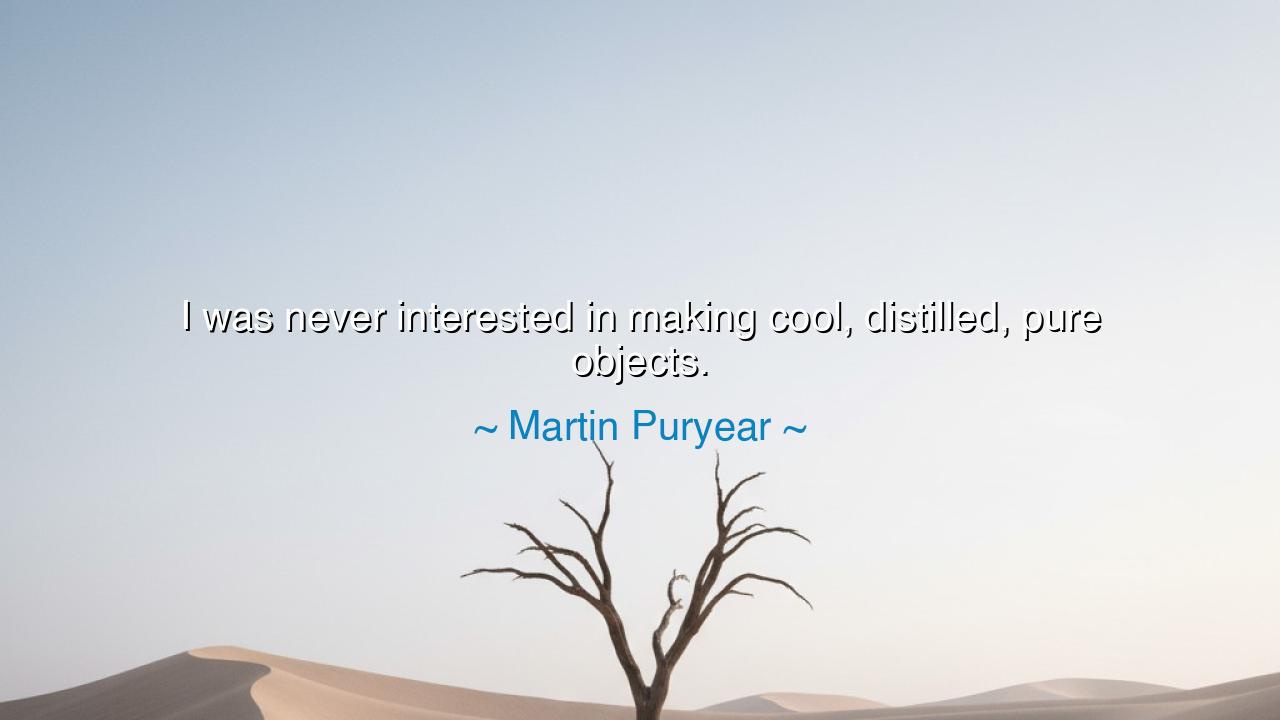
I was never interested in making cool, distilled, pure objects.






In the depths of human history, the greatest creators have often been those who rejected the easy pursuit of perfection and instead sought the richness that comes from the complexity and imperfections of the world. The ancient artists, sculptors, and philosophers did not merely seek to create pure and distilled forms that reflected the ideal; rather, they sought to capture the full range of human experience, with all its flaws, contradictions, and raw beauty. Martin Puryear’s words, “I was never interested in making cool, distilled, pure objects,” speak to this ancient wisdom—the understanding that true art lies not in the pursuit of the perfect, but in the embrace of complexity, depth, and authenticity.
Puryear’s statement reflects the ancient understanding that art is not just about creating something that is visually appealing or technically flawless, but about expressing the truth of the human condition, which is rarely ever perfect or ideal. The ancient Greeks, for example, sought beauty, but not the perfection of a single, pure form. The Parthenon, that great temple of Athens, is not built on flawless symmetry but on the imperfections that give it life, making it feel more human, more real. The slight curves and adjustments made in its design were not mistakes but conscious choices that allowed the building to speak to the viewer in a way that perfect geometry could not. In the same way, Puryear rejects the pursuit of cool, sterile objects, instead embracing the authenticity of work that is imperfect and human.
Consider the great sculptor Michelangelo, whose masterpieces, like the David and the Pietà, were not created as mere idealized forms, but as expressions of deep emotion, complexity, and life’s inherent tension. In his works, Michelangelo did not strive for purity in the sense of detached perfection; rather, he sought to capture the soul of his subjects. The David, for instance, is not a mere perfect figure of a hero, but a figure filled with strength and vulnerability, frozen at the moment before a battle, caught between action and reflection. Michelangelo’s work shows us that true art lies in the ability to reflect the complexity of life, rather than simply perfecting a single, unblemished form.
Puryear’s rejection of “pure objects” also calls to mind the way in which ancient philosophies viewed the idea of perfection. The Stoics, for instance, did not teach that life’s true meaning was found in achieving perfect outcomes, but in how we engage with the world—how we face adversity, embrace imperfection, and learn from life’s trials. For the Stoics, wisdom came from the ability to accept the world as it is, with all its flaws and chaos, and to act in harmony with the nature of existence. In much the same way, Puryear’s work and his philosophy suggest that true creativity is born not from striving for unattainable ideals, but from engaging deeply with the world around us, acknowledging its flaws, and turning them into something meaningful.
In the ancient Chinese tradition, the concept of wabi-sabi is another example of this wisdom—an aesthetic that values the beauty of imperfection. Wabi-sabi celebrates the weathered, the unfinished, and the worn, seeing in these imperfections not flaws, but stories, history, and a deeper connection to the world. A piece of wabi-sabi pottery, for example, may have visible cracks, but it is precisely these cracks that give it character, depth, and a soul that perfect, unbroken forms cannot achieve. Puryear’s rejection of pure, cool objects mirrors this same principle—the idea that art and creation are richer when they embrace complexity and imperfection rather than striving for some idealized, unattainable form.
The lesson here is profound: in art and in life, perfection is not the goal—authenticity, depth, and humanity are. By embracing our own imperfections and complexities, we can create works of beauty and meaning that reflect the truth of our existence. Puryear’s choice to reject pure, cool objects is a call to embrace the messiness of life, to create from a place of honesty rather than the pursuit of some unattainable standard. Whether in our art, relationships, or work, it is the imperfections that make us human and give us the strength to create something truly meaningful.
In your own life, take a moment to embrace your imperfections—in yourself, in others, and in the world around you. Stop chasing perfection, and instead, focus on the beauty of authenticity. Just as Michelangelo, Puryear, and the ancients did, create from a place of truth, and let the imperfections of your work and your life speak to the depth and richness of your journey. Life is not about achieving flawless results, but about finding meaning in every step, every flaw, and every moment of growth. True beauty comes from the imperfect, the unfinished, and the authentic.






AAdministratorAdministrator
Welcome, honored guests. Please leave a comment, we will respond soon